driver seat adjustment Seat Alhambra 2006 Owner's Manual
[x] Cancel search | Manufacturer: SEAT, Model Year: 2006, Model line: Alhambra, Model: Seat Alhambra 2006Pages: 299, PDF Size: 6.33 MB
Page 8 of 299
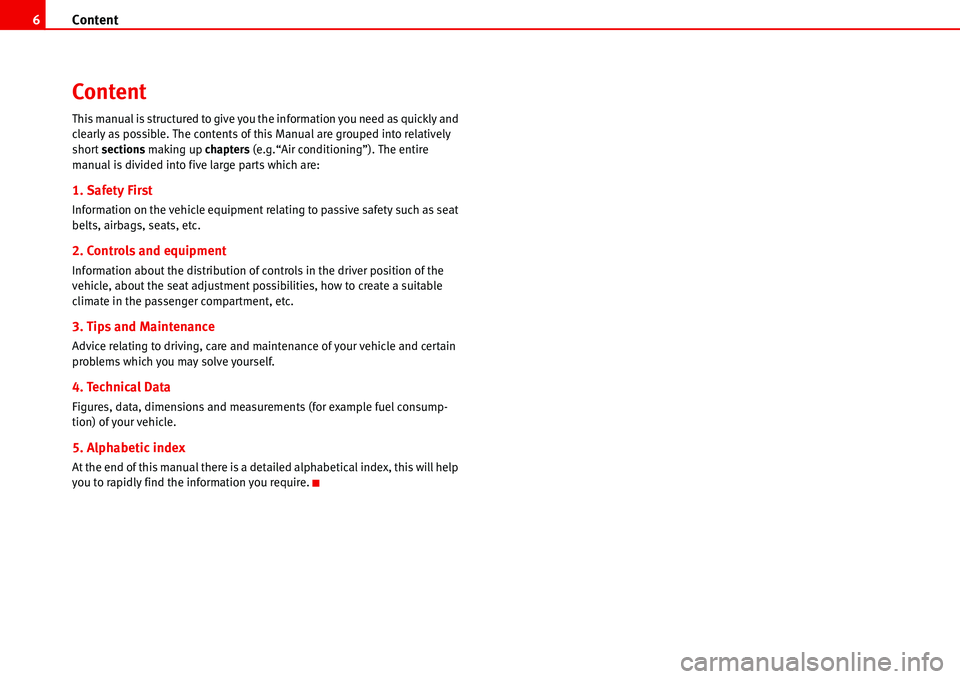
Content 6
Content
This manual is structured to give you the information you need as quickly and
clearly as possible. The contents of this Manual are grouped into relatively
short sections making up chapters (e.g.“Air conditioning”). The entire
manual is divided into five large parts which are:
1. Safety First
Information on the vehicle equipment relating to passive safety such as seat
belts, airbags, seats, etc.
2. Controls and equipment
Information about the distribution of controls in the driver position of the
vehicle, about the seat adjustment possibilities, how to create a suitable
climate in the passenger compartment, etc.
3. Tips and Maintenance
Advice relating to driving, care and maintenance of your vehicle and certain
problems which you may solve yourself.
4. Technical Data
Figures, data, dimensions and measurements (for example fuel consump-
tion) of your vehicle.
5. Alphabetic index
At the end of this manual there is a detailed alphabetical index, this will help
you to rapidly find the information you require.
Page 9 of 299
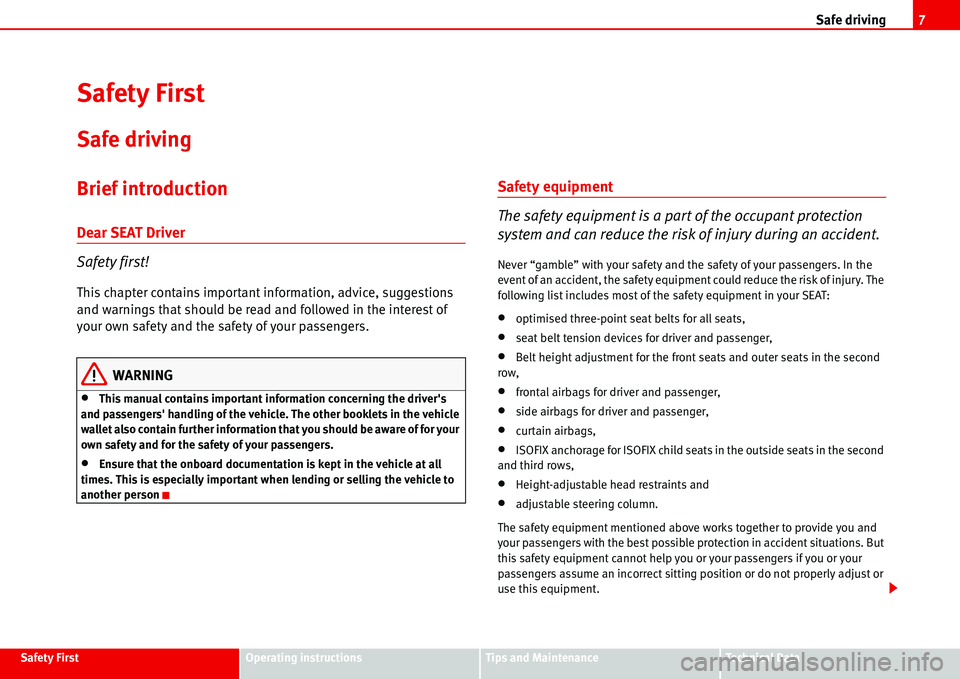
Safe driving7
Safety FirstOperating instructionsTips and MaintenanceTe c h n i c a l D a t a
Safety First
Safe driving
Brief introduction
Dear SEAT Driver
Safety first!
This chapter contains important information, advice, suggestions
and warnings that should be read and followed in the interest of
your own safety and the safety of your passengers.
WARNING
•This manual contains important information concerning the driver's
and passengers' handling of the vehicle. The other booklets in the vehicle
wallet also contain further information that you should be aware of for your
own safety and for the safety of your passengers.
•Ensure that the onboard documentation is kept in the vehicle at all
times. This is especially important when lending or selling the vehicle to
another person
Safety equipment
The safety equipment is a part of the occupant protection
system and can reduce the risk of injury during an accident.
Never “gamble” with your safety and the safety of your passengers. In the
event of an accident, the safety equipment could reduce the risk of injury. The
following list includes most of the safety equipment in your SEAT:
•optimised three-point seat belts for all seats,
•seat belt tension devices for driver and passenger,
•Belt height adjustment for the front seats and outer seats in the second
row,
•frontal airbags for driver and passenger,
•side airbags for driver and passenger,
•curtain airbags,
•ISOFIX anchorage for ISOFIX child seats in the outside seats in the second
and third rows,
•Height-adjustable head restraints and
•adjustable steering column.
The safety equipment mentioned above works together to provide you and
your passengers with the best possible protection in accident situations. But
this safety equipment cannot help you or your passengers if you or your
passengers assume an incorrect sitting position or do not properly adjust or
use this equipment.
Page 11 of 299

Safe driving9
Safety FirstOperating instructionsTips and MaintenanceTe c h n i c a l D a t a
– If possible, avoid driving when you are tired or are under pres-
sure of time.
WARNING
When driving safety is impaired during a trip, the risk of injury and acci-
dents increases.
Proper sitting position for occupants
Proper sitting position for driver
The proper sitting position for the driver is important for safe
and relaxed driving.
For your own safety and to reduce the risk of injury in the event of an
accident, we recommend the following adjustments for the driver:
– Adjust the steering wheel so that there is a distance of at least
25 cm between the steering wheel and the centre of your chest
�Ÿfig. 1.
– Move the driver's seat forwards or backwards so that you are able
to press the accelerator, brake and clutch pedals to the floor with
your knees still slightly angled �Ÿ.
– Ensure that you can reach the highest point of the steering
wheel.
– Adjust the head restraint so that its upper edge is at the same
level as the top of your head, or as close as possible to the same
level as the top of your head �Ÿfig. 2.
– Move the backrest to an upright position so that your back rests
completely against it.
Fig. 1 The proper
distance between driver
and steering wheel
Fig. 2 Proper head
restraint position for
driver
Page 12 of 299
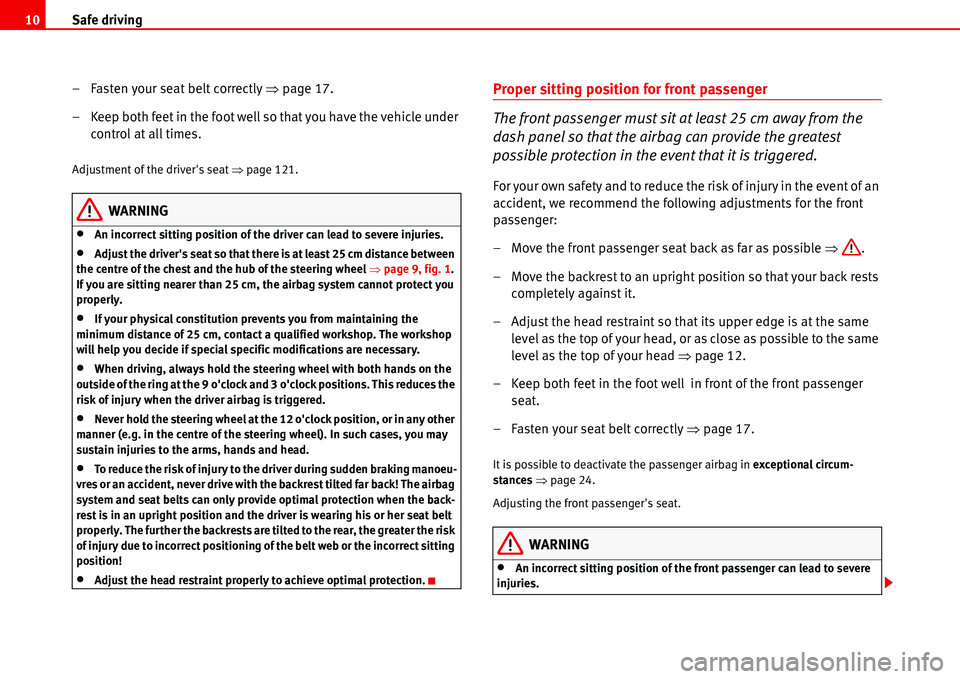
Safe driving 10
– Fasten your seat belt correctly �Ÿpage 17.
– Keep both feet in the foot well so that you have the vehicle under
control at all times.
Adjustment of the driver's seat �Ÿpage 121.
WARNING
•An incorrect sitting position of the driver can lead to severe injuries.
•Adjust the driver's seat so that there is at least 25 cm distance between
the centre of the chest and the hub of the steering wheel �Ÿpage 9, fig. 1.
If you are sitting nearer than 25 cm, the airbag system cannot protect you
properly.
•If your physical constitution prevents you from maintaining the
minimum distance of 25 cm, contact a qualified workshop. The workshop
will help you decide if special specific modifications are necessary.
•When driving, always hold the steering wheel with both hands on the
outside of the ring at the 9 o'clock and 3 o'clock positions. This reduces the
risk of injury when the driver airbag is triggered.
•Never hold the steering wheel at the 12 o'clock position, or in any other
manner (e.g. in the centre of the steering wheel). In such cases, you may
sustain injuries to the arms, hands and head.
•To reduce the risk of injury to the driver during sudden braking manoeu-
vres or an accident, never drive with the backrest tilted far back! The airbag
system and seat belts can only provide optimal protection when the back-
rest is in an upright position and the driver is wearing his or her seat belt
properly. The further the backrests are tilted to the rear, the greater the risk
of injury due to incorrect positioning of the belt web or the incorrect sitting
position!
•Adjust the head restraint properly to achieve optimal protection.
Proper sitting position for front passenger
The front passenger must sit at least 25 cm away from the
dash panel so that the airbag can provide the greatest
possible protection in the event that it is triggered.
For your own safety and to reduce the risk of injury in the event of an
accident, we recommend the following adjustments for the front
passenger:
– Move the front passenger seat back as far as possible �Ÿ.
– Move the backrest to an upright position so that your back rests
completely against it.
– Adjust the head restraint so that its upper edge is at the same
level as the top of your head, or as close as possible to the same
level as the top of your head �Ÿpage 12.
– Keep both feet in the foot well in front of the front passenger
seat.
– Fasten your seat belt correctly �Ÿpage 17.
It is possible to deactivate the passenger airbag in exceptional circum-
stances �Ÿpage 24.
Adjusting the front passenger's seat.
WARNING
•An incorrect sitting position of the front passenger can lead to severe
injuries.
Page 63 of 299
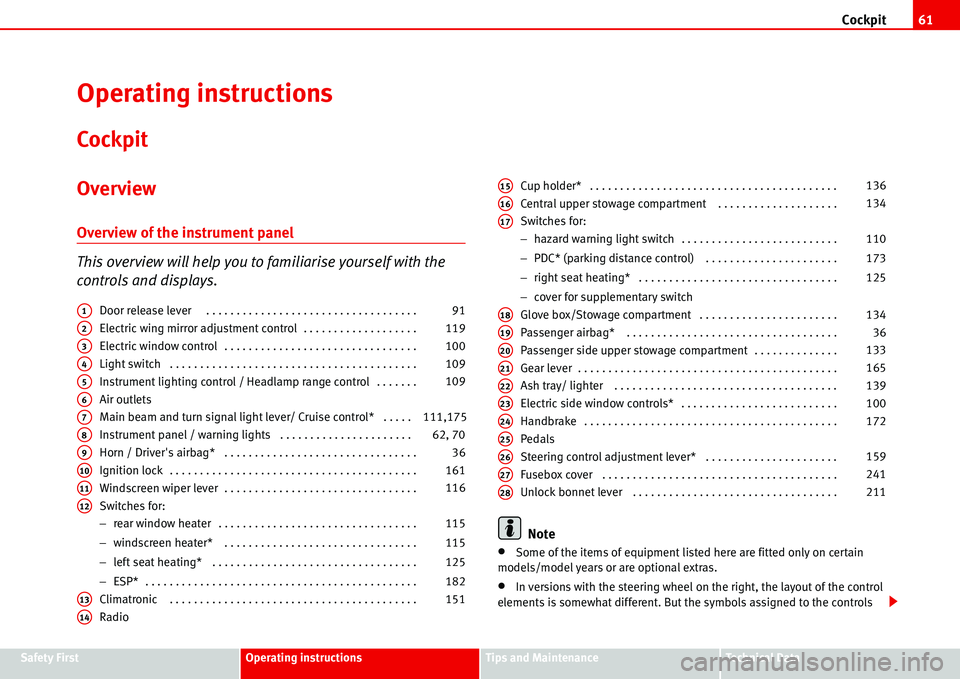
Cockpit61
Safety FirstOperating instructionsTips and MaintenanceTe c h n i c a l D a t a
Operating instructions
Cockpit
Overview
Overview of the instrument panel
This overview will help you to familiarise yourself with the
controls and displays.
Door release lever . . . . . . . . . . . . . . . . . . . . . . . . . . . . . . . . . . .
Electric wing mirror adjustment control . . . . . . . . . . . . . . . . . . .
Electric window control . . . . . . . . . . . . . . . . . . . . . . . . . . . . . . . .
Light switch . . . . . . . . . . . . . . . . . . . . . . . . . . . . . . . . . . . . . . . . .
Instrument lighting control / Headlamp range control . . . . . . .
Air outlets
Main beam and turn signal light lever/ Cruise control* . . . . .
Instrument panel / warning lights . . . . . . . . . . . . . . . . . . . . . .
Horn / Driver's airbag* . . . . . . . . . . . . . . . . . . . . . . . . . . . . . . . .
Ignition lock . . . . . . . . . . . . . . . . . . . . . . . . . . . . . . . . . . . . . . . . .
Windscreen wiper lever . . . . . . . . . . . . . . . . . . . . . . . . . . . . . . . .
Switches for:
−rear window heater . . . . . . . . . . . . . . . . . . . . . . . . . . . . . . . . .
−windscreen heater* . . . . . . . . . . . . . . . . . . . . . . . . . . . . . . . .
−left seat heating* . . . . . . . . . . . . . . . . . . . . . . . . . . . . . . . . . .
−ESP* . . . . . . . . . . . . . . . . . . . . . . . . . . . . . . . . . . . . . . . . . . . . .
Climatronic . . . . . . . . . . . . . . . . . . . . . . . . . . . . . . . . . . . . . . . . .
RadioCup holder* . . . . . . . . . . . . . . . . . . . . . . . . . . . . . . . . . . . . . . . . .
Central upper stowage compartment . . . . . . . . . . . . . . . . . . . .
Switches for:
−hazard warning light switch . . . . . . . . . . . . . . . . . . . . . . . . . .
−PDC* (parking distance control) . . . . . . . . . . . . . . . . . . . . . .
−right seat heating* . . . . . . . . . . . . . . . . . . . . . . . . . . . . . . . . .
−cover for supplementary switch
Glove box/Stowage compartment . . . . . . . . . . . . . . . . . . . . . . .
Passenger airbag* . . . . . . . . . . . . . . . . . . . . . . . . . . . . . . . . . . .
Passenger side upper stowage compartment . . . . . . . . . . . . . .
Gear lever . . . . . . . . . . . . . . . . . . . . . . . . . . . . . . . . . . . . . . . . . . .
Ash tray/ lighter . . . . . . . . . . . . . . . . . . . . . . . . . . . . . . . . . . . . .
Electric side window controls* . . . . . . . . . . . . . . . . . . . . . . . . . .
Handbrake . . . . . . . . . . . . . . . . . . . . . . . . . . . . . . . . . . . . . . . . . .
Pedals
Steering control adjustment lever* . . . . . . . . . . . . . . . . . . . . . .
Fusebox cover . . . . . . . . . . . . . . . . . . . . . . . . . . . . . . . . . . . . . . .
Unlock bonnet lever . . . . . . . . . . . . . . . . . . . . . . . . . . . . . . . . . .
Note
•Some of the items of equipment listed here are fitted only on certain
models/model years or are optional extras.
•In versions with the steering wheel on the right, the layout of the control
elements is somewhat different. But the symbols assigned to the controls
A191
A2119
A3100
A4109
A5109
A6
A7 111,175
A862, 70
A936
A10161
A11116
A12
115
115
125
182
A13151
A14
A15136
A16134
A17
110
173
125
A18134
A1936
A20133
A21165
A22139
A23100
A24172
A25
A26159
A27241
A28211
Page 123 of 299
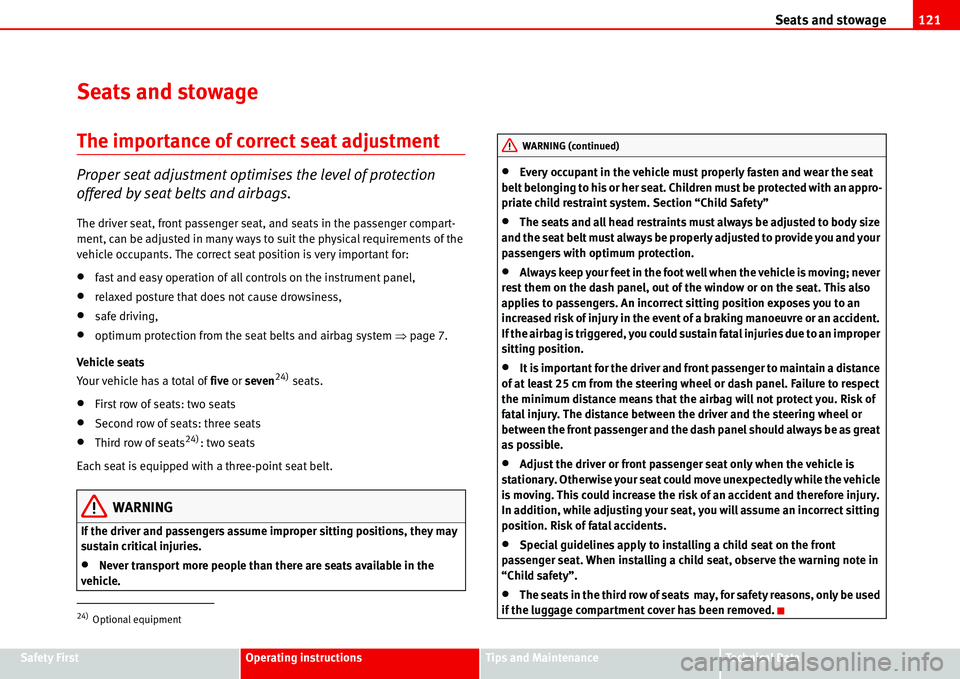
Seats and stowage121
Safety FirstOperating instructionsTips and MaintenanceTe c h n i c a l D a t a
Seats and stowage
The importance of correct seat adjustment
Proper seat adjustment optimises the level of protection
offered by seat belts and airbags.
The driver seat, front passenger seat, and seats in the passenger compart-
ment, can be adjusted in many ways to suit the physical requirements of the
vehicle occupants. The correct seat position is very important for:
•fast and easy operation of all controls on the instrument panel,
•relaxed posture that does not cause drowsiness,
•safe driving,
•optimum protection from the seat belts and airbag system �Ÿpage 7.
Vehicle seats
Your vehicle has a total of five or seven
24) seats.
•First row of seats: two seats
•Second row of seats: three seats
•Third row of seats24): two seats
Each seat is equipped with a three-point seat belt.
WARNING
If the driver and passengers assume improper sitting positions, they may
sustain critical injuries.
•Never transport more people than there are seats available in the
vehicle.
•Every occupant in the vehicle must properly fasten and wear the seat
belt belonging to his or her seat. Children must be protected with an appro-
priate child restraint system. Section “Child Safety”
•The seats and all head restraints must always be adjusted to body size
and the seat belt must always be properly adjusted to provide you and your
passengers with optimum protection.
•Always keep your feet in the foot well when the vehicle is moving; never
rest them on the dash panel, out of the window or on the seat. This also
applies to passengers. An incorrect sitting position exposes you to an
increased risk of injury in the event of a braking manoeuvre or an accident.
If the airbag is triggered, you could sustain fatal injuries due to an improper
sitting position.
•It is important for the driver and front passenger to maintain a distance
of at least 25 cm from the steering wheel or dash panel. Failure to respect
the minimum distance means that the airbag will not protect you. Risk of
fatal injury. The distance between the driver and the steering wheel or
between the front passenger and the dash panel should always be as great
as possible.
•Adjust the driver or front passenger seat only when the vehicle is
stationary. Otherwise your seat could move unexpectedly while the vehicle
is moving. This could increase the risk of an accident and therefore injury.
In addition, while adjusting your seat, you will assume an incorrect sitting
position. Risk of fatal accidents.
•Special guidelines apply to installing a child seat on the front
passenger seat. When installing a child seat, observe the warning note in
“Child safety”.
•The seats in the third row of seats may, for safety reasons, only be used
if the luggage compartment cover has been removed.
24)Optional equipment
WARNING (continued)
Page 161 of 299

Driving159
Safety FirstOperating instructionsTips and MaintenanceTe c h n i c a l D a t a
Driving
Steering
Adjusting the steering wheel position
The height and reach of the steering wheel can be freely
adjusted to suit the driver.
– Adjust the driver seat to the correct position.
– Push the lever under the steering column �Ÿfig. 123 down
�Ÿ.
– Adjust the steering wheel in this way until the correct position is
set �Ÿfig. 124.
– Then push the lever up again firmly �Ÿ.
WARNING
•Incorrect use of the steering column adjustment function and an incor-
rect seating position can result in serious injury.
•To avoid accidents, the steering column should be adjusted only when
the vehicle is stationary. Risk of accident.
Fig. 123 Adjusting the
steering wheel position
Fig. 124 Proper sitting
position for driver
Page 295 of 299
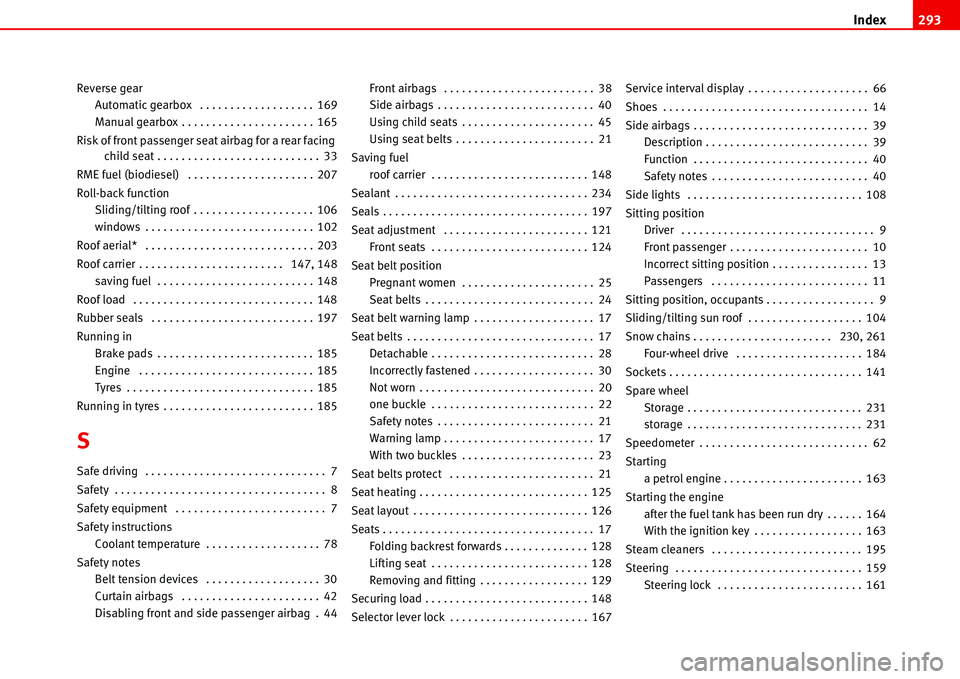
Index293
Reverse gear
Automatic gearbox . . . . . . . . . . . . . . . . . . . 169
Manual gearbox . . . . . . . . . . . . . . . . . . . . . . 165
Risk of front passenger seat airbag for a rear facing
child seat . . . . . . . . . . . . . . . . . . . . . . . . . . . 33
RME fuel (biodiesel) . . . . . . . . . . . . . . . . . . . . . 207
Roll-back function
Sliding/tilting roof . . . . . . . . . . . . . . . . . . . . 106
windows . . . . . . . . . . . . . . . . . . . . . . . . . . . . 102
Roof aerial* . . . . . . . . . . . . . . . . . . . . . . . . . . . . 203
Roof carrier . . . . . . . . . . . . . . . . . . . . . . . . 147, 148
saving fuel . . . . . . . . . . . . . . . . . . . . . . . . . . 148
Roof load . . . . . . . . . . . . . . . . . . . . . . . . . . . . . . 148
Rubber seals . . . . . . . . . . . . . . . . . . . . . . . . . . . 197
Running in
Brake pads . . . . . . . . . . . . . . . . . . . . . . . . . . 185
Engine . . . . . . . . . . . . . . . . . . . . . . . . . . . . . 185
Tyres . . . . . . . . . . . . . . . . . . . . . . . . . . . . . . . 185
Running in tyres . . . . . . . . . . . . . . . . . . . . . . . . . 185
S
Safe driving . . . . . . . . . . . . . . . . . . . . . . . . . . . . . . 7
Safety . . . . . . . . . . . . . . . . . . . . . . . . . . . . . . . . . . . 8
Safety equipment . . . . . . . . . . . . . . . . . . . . . . . . . 7
Safety instructions
Coolant temperature . . . . . . . . . . . . . . . . . . . 78
Safety notes
Belt tension devices . . . . . . . . . . . . . . . . . . . 30
Curtain airbags . . . . . . . . . . . . . . . . . . . . . . . 42
Disabling front and side passenger airbag . 44Front airbags . . . . . . . . . . . . . . . . . . . . . . . . . 38
Side airbags . . . . . . . . . . . . . . . . . . . . . . . . . . 40
Using child seats . . . . . . . . . . . . . . . . . . . . . . 45
Using seat belts . . . . . . . . . . . . . . . . . . . . . . . 21
Saving fuel
roof carrier . . . . . . . . . . . . . . . . . . . . . . . . . . 148
Sealant . . . . . . . . . . . . . . . . . . . . . . . . . . . . . . . . 234
Seals . . . . . . . . . . . . . . . . . . . . . . . . . . . . . . . . . . 197
Seat adjustment . . . . . . . . . . . . . . . . . . . . . . . . 121
Front seats . . . . . . . . . . . . . . . . . . . . . . . . . . 124
Seat belt position
Pregnant women . . . . . . . . . . . . . . . . . . . . . . 25
Seat belts . . . . . . . . . . . . . . . . . . . . . . . . . . . . 24
Seat belt warning lamp . . . . . . . . . . . . . . . . . . . . 17
Seat belts . . . . . . . . . . . . . . . . . . . . . . . . . . . . . . . 17
Detachable . . . . . . . . . . . . . . . . . . . . . . . . . . . 28
Incorrectly fastened . . . . . . . . . . . . . . . . . . . . 30
Not worn . . . . . . . . . . . . . . . . . . . . . . . . . . . . . 20
one buckle . . . . . . . . . . . . . . . . . . . . . . . . . . . 22
Safety notes . . . . . . . . . . . . . . . . . . . . . . . . . . 21
Warning lamp . . . . . . . . . . . . . . . . . . . . . . . . . 17
With two buckles . . . . . . . . . . . . . . . . . . . . . . 23
Seat belts protect . . . . . . . . . . . . . . . . . . . . . . . . 21
Seat heating . . . . . . . . . . . . . . . . . . . . . . . . . . . . 125
Seat layout . . . . . . . . . . . . . . . . . . . . . . . . . . . . . 126
Seats . . . . . . . . . . . . . . . . . . . . . . . . . . . . . . . . . . . 17
Folding backrest forwards . . . . . . . . . . . . . . 128
Lifting seat . . . . . . . . . . . . . . . . . . . . . . . . . . 128
Removing and fitting . . . . . . . . . . . . . . . . . . 129
Securing load . . . . . . . . . . . . . . . . . . . . . . . . . . . 148
Selector lever lock . . . . . . . . . . . . . . . . . . . . . . . 167Service interval display . . . . . . . . . . . . . . . . . . . . 66
Shoes . . . . . . . . . . . . . . . . . . . . . . . . . . . . . . . . . . 14
Side airbags . . . . . . . . . . . . . . . . . . . . . . . . . . . . . 39
Description . . . . . . . . . . . . . . . . . . . . . . . . . . . 39
Function . . . . . . . . . . . . . . . . . . . . . . . . . . . . . 40
Safety notes . . . . . . . . . . . . . . . . . . . . . . . . . . 40
Side lights . . . . . . . . . . . . . . . . . . . . . . . . . . . . . 108
Sitting position
Driver . . . . . . . . . . . . . . . . . . . . . . . . . . . . . . . . 9
Front passenger . . . . . . . . . . . . . . . . . . . . . . . 10
Incorrect sitting position . . . . . . . . . . . . . . . . 13
Passengers . . . . . . . . . . . . . . . . . . . . . . . . . . 11
Sitting position, occupants . . . . . . . . . . . . . . . . . . 9
Sliding/tilting sun roof . . . . . . . . . . . . . . . . . . . 104
Snow chains . . . . . . . . . . . . . . . . . . . . . . . 230, 261
Four-wheel drive . . . . . . . . . . . . . . . . . . . . . 184
Sockets . . . . . . . . . . . . . . . . . . . . . . . . . . . . . . . . 141
Spare wheel
Storage . . . . . . . . . . . . . . . . . . . . . . . . . . . . . 231
storage . . . . . . . . . . . . . . . . . . . . . . . . . . . . . 231
Speedometer . . . . . . . . . . . . . . . . . . . . . . . . . . . . 62
Starting
a petrol engine . . . . . . . . . . . . . . . . . . . . . . . 163
Starting the engine
after the fuel tank has been run dry . . . . . . 164
With the ignition key . . . . . . . . . . . . . . . . . . 163
Steam cleaners . . . . . . . . . . . . . . . . . . . . . . . . . 195
Steering . . . . . . . . . . . . . . . . . . . . . . . . . . . . . . . 159
Steering lock . . . . . . . . . . . . . . . . . . . . . . . . 161